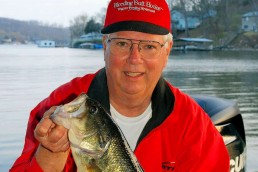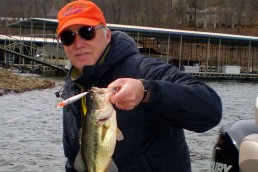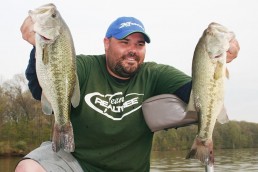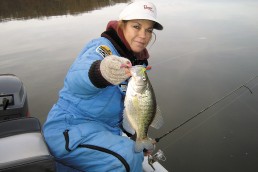Coldwater Bassin’ with a Jerkbait: How it Came About
SHARE THIS POST
Legends experiment with lures, bring them to public
The late-winter bass fishing season will soon be here in the Midwest. In fact, it is already here in some warm-water discharge lakes and highland reservoirs of the mid-South.
Some nearby warm-water lakes include Clinton (Clinton, Ill.), Newton (Newton, Ill.), Thomas Hill (Macon, Mo.) lakes and Lake of Egypt (Marion, Ill.). Cold-water highland reservoirs, like Truman (Warsaw, Mo.) and Table Rock (Branson, Mo.) lakes, Lake of the Ozarks (Osage Beach, Mo.), or Norfork and Bull Shoals (Mountain Home, Ark.) lakes provide some open water all winter for bass anglers.
A perennial favorite lure for the cold-water period resembles a long, slender minnow, often called a jerkbait, and was first developed by Lauri Rapala. It was an invention of necessity instead of consumerism.
Rapala, a commercial fisherman in Finland, was convinced he could catch more fish each day using an artificial lure than he could with live bait. As a young man, Rapala worked as a lumberjack in winter and as a commercial fisherman in summer. At the time, he could make more money selling trout than working in a factory.
However, life as a Finnish commercial fisherman was anything but easy in the 1930s. Each day—weather permitting—he rowed his boat 30 miles trolling a trotline with nearly 1,000 hooks. Between the rowing and keeping bait on the hooks, the task was daunting.
As Rapala rowed and trolled, he watched baitfish, observing their swimming motions and reasoned an artificial lure mimicking a minnow’s movement could catch more fish in a day because no time would be wasted baiting hooks.
After much trial and error, his “invention” was ready for serious use. Hand carved from cork, he covered his creation with tin foil and a coating of melted photograph negatives. The result was an artificial lure with a natural appearance that wobbled like an injured minnow.
The lures worked so well that he began making and selling them. He could not produce the necessary quantities himself, so he enlisted the help of his sons. Soon they developed machines to carve each lure identically from one to the next. Even with that technology, Rapala insisted each lure be tank-tested for his final approval.
Called the “Original Floater,” Rapala’s creation built a solid fish-catching reputation in Europe. Exported to the United States after enjoying great success on Europe’s pike, perch, and trout, the lure enjoyed significant success in the North and Canada because of its reputation for catching the same species.
Lauri Rapala could not have foreseen the success nor the impact his “Original Floater” would have on the bass fishing industry, however.
Are you enjoying this post?
You can be among the first to get the latest info on where to go, what to use and how to use it!
After pondering the success of Rapala’s Original Floater, an American named Jack Smithwick began carving similar lures in the kitchen using his wife’s broom handles—an act that could not have made him too popular around the house. He reasoned the shape and action would be deadly for largemouths, but the lure needed to be heavier for traditional baitcasting tackle.
Smithwick gave these lures to business associates as tokens of appreciation. They became so popular he moved his hobby from the kitchen to the garage. And, much to his wife’s relief, Smithwick began purchasing wood from the lumberyard.
As word of his hand-carved treasures spread throughout the fishing community, anglers clamored for the lures. Smithwick’s Rogue became the standard for all minnow-shaped jerkbaits to imitate. In fact, Rogue is as synonymous to jerkbaits as Xerox is to copiers.
However, the difference between Rapala’s technique and the way cold-water bass anglers fish the lure is vastly different. As a commercial fisherman, Rapala trolled his lure on a trotline. Later production models were cast and slowly retrieved. Today’s cold-water bass angler fishes them with a jerk-and-pause retrieve, with pauses up to 30 seconds or more.
Bass anglers are aware of the Rogue’s cold-water bass-catching ability, especially in warm water discharge and mid-South reservoirs. While no serious bass angler would be without a supply of jerkbaits in the boat, Rapala and Rogue are not the only choices.
Anglers can choose from a plethora of brands that cost under $10 like Bagley, Bass Pro Shops, Berkley, Bomber, Cabela’s, Cordell, Lucky-E-Strike, Rapala, Rebel, Reef Runner, Stick Master, Storm, Strike King and Yo-Zuri,
Jerkbaits brands that cost over $15 include Jackall, LiveTarget, Livingston Lures, Lucky Craft, Megabass and Spro.
With product lists like these, where does an angler start?
Beyond the selection or elimination due to cost, get advice from local bait shops and guides, since some lures work better than others depending on the lake and forage. Also, check tournament results on the Internet for clues on brands and colors.
So that is the jerkbait story, and how Lauri Rapala hand carved a lure in Finland that changed the landscape of coldwater bass fishing in North America.
MWO
SHARE THIS POST
Did you enjoy this post?
You can be among the first to get the latest info on where to go, what to use and how to use it!
Darrell Taylor
Darrell Taylor has fished for more than 65 years. During the past 25 years, Taylor has generated more than 2,000 published articles, columns and fishing reports. His writings received 14 peer-level awards from outdoor writer organizations, including the Association of Great Lakes Outdoor Writers “Excellence in Craft” Golden Glow Award, their highest recognition.




